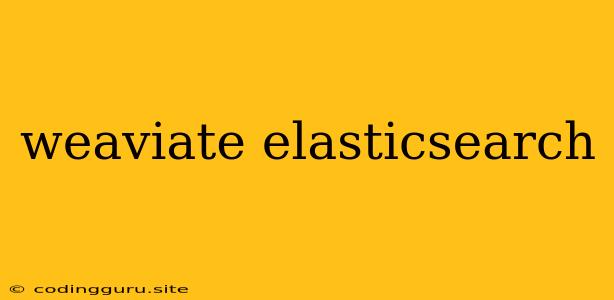Weaviate vs. Elasticsearch: Which is the Right Choice for You?
When it comes to building powerful search experiences for your applications, Weaviate and Elasticsearch are two prominent players in the field. Both offer robust capabilities for indexing and retrieving data, but they come with distinct strengths and weaknesses. Choosing the right one depends on your specific needs and priorities.
What is Weaviate?
Weaviate is a vector search engine built on top of a knowledge graph. It combines the power of semantic search with the speed of vector indexing. This means Weaviate can understand the relationships and context within your data, allowing it to provide more accurate and relevant search results.
What is Elasticsearch?
Elasticsearch is a highly scalable, distributed search engine based on Lucene. It excels in keyword-based search, effectively handling large volumes of data and complex queries. It is widely known for its speed and flexibility, making it a popular choice for various applications, including e-commerce, logging, and analytics.
Key Differences Between Weaviate and Elasticsearch
Let's delve into the key differences that can help you determine which tool is best suited for your project.
1. Indexing and Querying:
- Weaviate:
- Vector indexing: Weaviate uses vector embeddings to represent data points, allowing it to understand the semantic relationships between objects. This enables more natural and context-aware search experiences.
- Semantic search: Weaviate excels in understanding the meaning behind your queries. It can handle complex queries that involve multiple concepts and relationships.
- Elasticsearch:
- Keyword-based indexing: Elasticsearch indexes data based on keywords, making it highly effective for searching specific terms and phrases.
- Boolean queries: Elasticsearch supports complex boolean queries, allowing you to combine multiple search terms and refine your results.
2. Data Modeling:
- Weaviate:
- Knowledge graph: Weaviate's knowledge graph structure allows you to define relationships between different objects, creating a rich and interconnected data model. This facilitates understanding the context of your data and improves the accuracy of search results.
- Elasticsearch:
- Document-oriented: Elasticsearch primarily uses a document-oriented data model, where data is stored in JSON documents. It offers flexible schema and supports various data types.
3. Use Cases:
- Weaviate:
- Semantic search: Weaviate is ideal for applications that require understanding the meaning behind queries, such as customer support chatbots, personalized recommendations, and knowledge discovery.
- Natural language processing (NLP): Weaviate's ability to handle natural language queries makes it well-suited for NLP tasks, including question answering, sentiment analysis, and text summarization.
- Elasticsearch:
- Keyword-based search: Elasticsearch excels at keyword-based search, making it suitable for e-commerce applications, log analysis, and real-time analytics.
- Structured data search: Elasticsearch is a robust choice for searching structured data, such as product catalogs, user profiles, and event logs.
When to Choose Weaviate
- You need to understand the context and relationships within your data.
- You want to implement semantic search capabilities.
- You're working with unstructured data, such as text documents, images, or audio files.
- You need a platform that supports natural language processing tasks.
When to Choose Elasticsearch
- You require high-performance keyword-based search capabilities.
- You have large volumes of data to index and search.
- You're working with structured data and need to perform complex queries.
- You're building real-time analytics dashboards or monitoring systems.
Weaviate and Elasticsearch: A Complementary Approach
While Weaviate and Elasticsearch cater to different needs, they can also work together seamlessly. You can use Weaviate for semantic search and knowledge discovery and then leverage Elasticsearch for high-performance keyword-based search on the retrieved data.
Example Scenario
Imagine you are building an e-commerce platform. You can use Weaviate to index your product catalog, including product descriptions, reviews, and images. This allows customers to search for products using natural language queries like "show me stylish running shoes for women" or "find me a sustainable coffee machine". Weaviate can understand the context of these queries and retrieve relevant products.
Once you have the initial set of results from Weaviate, you can use Elasticsearch to filter and refine the results based on specific keywords, price ranges, or other attributes. This combination of semantic search and keyword-based search offers a powerful and user-friendly experience for your customers.
Conclusion
The choice between Weaviate and Elasticsearch boils down to your specific requirements. Weaviate excels in semantic search and knowledge discovery, while Elasticsearch is renowned for its speed and scalability in keyword-based search. By understanding the strengths and weaknesses of each platform, you can select the best tool to meet your unique needs and build exceptional search experiences for your applications.
